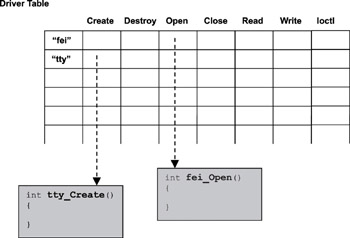Книга: Real-Time Concepts for Embedded Systems
12.3.2 Mapping Generic Functions to Driver Functions
12.3.2 Mapping Generic Functions to Driver Functions
The individual device drivers provide the actual implementation of each function in the uniform I/O API set. Figure 12.6 gives an overview of the relationship between the I/O API set and driver internal function set.

Figure 12.6: I/O function mapping.
As illustrated in Figure 12.6, the I/O subsystem-defined API set needs to be mapped into a function set that is specific to the device driver for any driver that supports uniform I/O. The functions that begin with the driver_ prefix in Figure 12.6 refer to implementations that are specific to a device driver. The uniform I/O API set can be represented in the C programming language syntax as a structure of function pointers, as shown in the left-hand side of Listing 12.1.
Listing 12.1: C structure defining the uniform I/O API set.
typedef struct {
int (*Create)();
int (*Open) ();
int (*Read)();
int (*Write) ();
int (*Close) ();
int (*Ioctl) ();
int (*Destroy) ();
} UNIFORM_IO_DRV;
The mapping process involves initializing each function pointer with the address of an associated internal driver function, as shown in Listing 12.2. These internal driver functions can have any name as long as they are correctly mapped.
Listing 12.2: Mapping uniform I/O API to specific driver functions.
UNIFORM_IO_DRV ttyIOdrv;
ttyIOdrv.Create = tty_Create;
ttyIOdrv.Open = tty_Open;
ttyIOdrv.Read = tty_Read;
ttyIOdrv.Write = tty_Write;
ttyIOdrv.Close = tty_Close;
ttyIOdrv.Ioctl = tty_Ioctl;
ttyIOdrv.Destroy = tty_Destroy;
An I/O subsystem usually maintains a uniform I/O driver table. Any driver can be installed into or removed from this driver table by using the utility functions that the I/O subsystem provides. Figure 12.7 illustrates this concept.

Figure 12.7: Uniform I/O driver table.
Each row in the table represents a unique I/O driver that supports the defined API set. The first column of the table is a generic name used to associate the uniform I/O driver with a particular type of device. In Figure 12.7, a uniform I/O driver is provided for a serial line terminal device, tty. The table element at the second row and column contains a pointer to the internal driver function, tty_Create(). This pointer, in effect, constitutes an association between the generic create function and the driver-specific create function. The association is used later when creating virtual instances of a device.
These pointers are written to the table when a driver is installed in the I/O subsystem, typically by calling a utility function for driver installation. When this utility function is called, a reference to the newly created driver table entry is returned to the caller.




